Avec un nombre illimité de facteurs internes et externes qui ont un impact sur les opérations de chaque organisation, une crise potentielle n'est jamais très loin.
S'il est rare de pouvoir prédire une crise, il est en revanche possible de s'y préparer.
Dans cet article, nous examinerons l'anatomie d'un plan de communication de crise complet. Nous vous proposons également des modèles de plans de communication de crise prêts à l'emploi et spécifiques à votre secteur d'activité afin de vous aider à mieux vous préparer à toute éventualité.
Accès rapide aux modèles de plans de communication de crise :
⏬ Modèle de plan général de communication de crise
⏬ Modèle de plan de communication de crise pour les écoles
⏬ Modèle de plan de communication de crise pour les universités
⏬ Modèle de plan de communication de crise pour les entreprises
⏬ Modèle de plan de communication de crise technologique
⏬ Modèle de plan de communication de crise pour le secteur de l'hôtellerie
⏬ Modèle de plan de communication de crise pour les organisations à but non lucratif
⏬ Modèle de plan de communication de crise pour les hôpitaux
⏬ Modèle de plan de communication de crise le domaine du sport
⏬ Modèle de plan de communication de crise pour le transport et la logistique
⏬ Modèle de plan de communication de crise pour l'agriculture

Qu'est-ce que la communication de crise ?
Les crises sont des événements imprévisibles perçus comme :
- Menaçant les performances d'une organisation,
- Mettant en péril les attentes des parties prenantes et
- Entraînant des conséquences négatives.
Selon une définition, la communication de crise est « Le processus de création et d'échange de messages entre des parties prenantes interdépendantes dans des conditions de forte incertitude, de menaces pesant sur des objectifs hautement prioritaires et de nécessité d'une réponse immédiate créée par une crise ».
En d'autres termes, il s'agit de l'ensemble des messages qu'une organisation diffuse pour répondre à une crise.
La communication de crise peut avoir lieu en interne au sein de l'organisation et en externe, vers différents groupes de parties prenantes et le grand public.
La communication de crise interne et externe est tout aussi importante l'une que l'autre :
- La communication interne peut permettre aux employés et aux autres membres d'une organisation d'être performants en période de crise et les motiver à le faire.
- La communication externe protège la réputation de l'organisation aux yeux de ses parties prenantes et du public.
🎓 Astuce Pro de Pumble
Si vous souhaitez savoir quels sont les principes directeurs d'une communication de crise interne efficace, lisez notre guide :
Qu'est-ce qu'un plan de communication de crise ?
Un plan de communication de crise est un ensemble de lignes directrices, d'informations et de ressources qui constituent un schéma directeur pour une réponse rapide et efficace à une crise émergente.
Aussi connu comme le plan de la crise de la gestion, il comprend des étapes de communication et des processus opérationnels qui couvrent la durée d'une crise, depuis l'identification de ce qui se passe jusqu'à l'évaluation de l'après-crise.
Il rassemble toutes les informations pertinentes en un seul endroit et aide les organisations à formuler et à communiquer un ensemble de messages cohérents et homogènes qui les aideront à surmonter une crise — ou du moins à ne pas aggraver une situation déjà difficile.
Comment élaborer un plan de communication de crise ?
Les plans de communication de crise peuvent revêtir de nombreuses formes et tailles. Ils peuvent être simples ou extrêmement détaillés et peuvent inclure ou exclure certaines informations.
Quel que soit son format ou sa portée, tout plan de communication de crise complet doit couvrir les domaines suivants :
- Mécanismes d'alerte
- Définition de l'objectif,
- Définition des rôles et du personnel de l'équipe,
- Identification des principales parties prenantes,
- Identification des risques et des scénarios de crise potentiels,
- Guide à l'usage des employés,
- Collecte d'informations,
- Diffusion de l'information, et
- Évaluation post-crise.
Voyons ce que ces étapes représentent et comment chacune d'entre elles contribue à une stratégie de communication de crise réussie.
Étape 1 : Définition des mécanismes d'alerte
Cette étape fait référence aux activités internes dès la première notification d'une crise émergente.
Plus précisément, il définit ce qui se passe une fois la crise détectée :
- Qui doit être informé,
- Quels mécanismes sont déclenchés, et
- Quelles sont les étapes nécessaires pour que l'équipe d'intervention soit opérationnelle le plus rapidement possible.
Cette étape peut facilement être considérée comme l'étape 0, celle que toute organisation devrait mettre en œuvre avant même qu'une crise ne survienne.
La planification de mécanismes d'alerte peut s'avérer difficile, en particulier lorsque vous devez avertir rapidement de nombreuses parties.
Cependant, le fait de disposer de mécanismes d'alerte avant qu'une crise ne survienne peut vous donner un avantage indéniable et, dans de nombreux cas, empêcher une aggravation de la situation.
L'intégration de vos parties prenantes les plus importantes dans une application de communication dédiée permet une réaction initiale rapide, en particulier lorsque le temps est compté.
Vous avez besoin d'une application de communication ? Testez Pumble
Étape 2 : Définition de l'objectif
Dans le cadre d'un plan de communication de crise, définir l'objectif ne consiste pas à rédiger une déclaration de mission vague et abstraite, mais à donner une définition très pratique de la portée du document.
Définir l'objectif implique de définir le but de votre plan de communication et ses objectifs de communication.
Par exemple, le plan peut être destiné uniquement à la communication de crise interne, exclusivement aux médias, au grand public, à des groupes spécifiques de parties prenantes, ou à tous ces acteurs à la fois.
Demandez-vous : quel est le principal objectif que nous devons atteindre, et la seule chose que nous devons éviter ?
Comprendre la portée, le but et les objectifs de la communication de crise vous permettra de concevoir la bonne approche.
Étapes 3 : Définition des rôles et le personnel de l'équipe
Le fait de disposer d'une équipe de réaction dédiée à la crise, dont les rôles et les responsabilités sont clairement définis, constitue une base solide pour une gestion efficace de la crise.
Une équipe de réaction à une crise est censée organiser et coordonner une série de tâches liées à quatre domaines d'activité principaux :
- Collecte d'informations,
- Prise de décision,
- Formulation de messages et
- Communication des messages.
La composition d'une équipe d'intervention sera largement déterminée par les spécificités du travail d'une organisation.
Toutefois, la répartition générale des rôles clés reste assez universelle :
- Des porte-parole internes et externes désignés,
- Des experts et des détenteurs de connaissances dans les domaines concernés,
- Des représentants de l'encadrement supérieur dotés de pouvoirs de décision et
- Un nombre nécessaire de coordinateurs et de personnel technique pour les questions opérationnelles.
Dans toute situation de crise, un esprit vif, une capacité à prendre des décisions et une approche cohérente pour résoudre les problèmes sont les qualités les plus importantes que doit posséder le décideur clé. Gardez cela à l'esprit lorsque vous constituez votre équipe.
L'un des moyens les plus simples de simplifier le processus de définition des responsabilités en cas de crise consiste à organiser votre équipe sur une plateforme de communication dédiée.
N'oubliez pas qu'une meilleure communication interne et une formation à la communication sont d'une importance capitale pour toute organisation, non seulement en situation de crise, mais aussi avant même qu'une crise ne survienne.
Simplifier la communication interne avec Pumble
Étapes 4 : Identification des principales parties prenantes
Les parties prenantes sont des individus et des groupes sans le soutien desquels les organisations cesseraient d'exister.
Selon leur degré d'implication dans l'organisation, les parties prenantes peuvent être :
- Primaires (employés, clients, actionnaires, fournisseurs, etc.) et
- Secondaires (grand public, médias, groupes d'activistes).
L'identification et la hiérarchisation des principales parties prenantes nous permettent de mieux comprendre nos principaux objectifs de communication et nos publics cibles, et de les aborder en conséquence.
Étapes 5 : Identification des risques et des scénarios de crise potentiels
S'il est souvent très difficile de prévoir exactement le moment et la nature d'une crise, nous pouvons néanmoins nous préparer aux éventualités les plus probables.
La première étape de ce processus consiste à évaluer les opérations et à identifier les faiblesses visibles et les domaines présentant un risque accru de perturbations et d'instabilité.
Une fois les zones à risque identifiées, nous pouvons formuler des scénarios de crise et préparer les processus et les messages pour une réponse.
Si la crise est déjà survenue, la première chose à faire est d'évaluer le pire scénario d'escalade et d'essayer de réduire les risques qu'il se produise.
Une bonne organisation et une collaboration forte au sein de l'équipe seront très probablement déterminantes pour l'efficacité de votre réponse.
Étapes 6 : Guide à l'usage des employés
Lorsqu'une crise s'aggrave, il est difficile de maîtriser la conversation qui l'entoure, en particulier dans le monde actuel des médias sociaux et d'autres plateformes individuelles.
Les organisations doivent définir la manière dont elles attendent de leurs membres qu'ils gèrent les communications professionnelles sur leurs canaux personnels dans les situations de crise et fournir des lignes directrices claires et applicables.
Bien que chaque organisation définisse ses politiques comme elle l'entend, l'expérience a montré qu'au lieu d'essayer de censurer ou de faire taire les voix des employés, il est préférable d'adopter les réseaux sociaux et de leur fournir des informations et des conseils fiables et de leur permettre de représenter au mieux l'organisation.
Étapes 7 : Collecte d'informations
Avant de pouvoir formuler ses messages, l'équipe d'intervention doit rassembler toutes les informations disponibles sur ce qui s'est passé et sur les mesures prises pour gérer la crise.
Pour cela, il est essentiel d'identifier les détenteurs d'informations clés dans différents domaines de l'organisation et de les inclure dans l'équipe d'intervention ou de les rendre facilement disponibles pour consultation via un canal de communication dédié.
L'équipe d'intervention devra continuer à recueillir des informations fiables et à fonder ses messages sur celles-ci pendant toute la durée de la crise.
De nombreux plans de communication de crise comprennent une fiche d'information, c'est-à-dire une liste de toutes les informations vérifiées disponibles sur la crise. Cela permet de s'assurer que les membres de l'équipe d'intervention (ainsi que toutes les autres parties concernées) disposent des mêmes informations et s'accordent sur leur interprétation.
Centralisez la communication de votre équipe avec Pumble
Étapes 8 : Diffusion de l'information
Cette étape consiste à préparer la communication par les canaux définis.
Un plan de communication de crise doit répondre aux questions clés suivantes :
- Que faut-il communiquer ?
- Qui le communique ?
- Quand communiquent-ils cette information (c'est-à-dire le moment et la fréquence de communication) ?
- Comment communiquent-ils cette information (c'est-à-dire empathie, transparence, etc.) ?
- Par quels canaux communiquent-ils cette information (c'est-à-dire déclarations, communiqués de presse, annonces sur les réseaux sociaux, etc.) ?
La distribution de l'information va des systèmes d'alerte d'urgence aux relations avec les médias, en passant par la communication interne.
Un plan solide peut :
- Définir et détailler tous les canaux de communication pertinents et les groupes qui doivent être atteints par ces canaux, et
- Inclure toutes les personnes chargées des relations publiques.
🎓 Astuce Pro de Pumble
La distribution de l'information devient encore plus complexe à distance. Pour maîtriser le partage de l'information à distance, lisez notre guide :
Partager les informations avec l'équipe avec Pumble
Étapes 9 : Évaluation post-crise
Le travail de l'équipe d'intervention ne s'arrête pas à la désescalade d'une crise. L'évaluation post-crise de la réponse de l'organisation permet de mieux préparer l'avenir.
L'équipe d'intervention doit :
- Évaluer correctement la qualité de l'intervention,
- Prendre note des pratiques qui ont donné des résultats positifs,
- Noter des faiblesses du plan, et
- Adresser toutes les faiblesses dans le plan pour les situations futures.
L'évaluation peut être menée par les membres de l'équipe d'intervention ou par un groupe plus large de parties prenantes internes.
🎓Astuce Pro de Pumble
Pour savoir comment tirer le meilleur parti de feedback afin d'évaluer et d'améliorer la communication au sein de votre équipe, consultez notre blog :
Les risques d'une mauvaise communication de crise
La communication de crise en elle-même ne nécessite pas de plan — les représentants d'une organisation touchée par une crise devront communiquer, qu'ils y soient préparés ou non.
Cependant, de nombreux managers ont tenté d'improviser, et une multitude de preuves empiriques suggèrent fortement que c'est une mauvaise idée.
Il suffit de demander à Tony Hayward, l'ancien PDG de British Petroleum et l'acteur principal de ce qui est devenu le pire désastre de l'histoire en matière de relations publiques.
Exemple de communication de crise non planifiée
Voici un exemple parfait illustrant à quel point une communication de crise non planifiée peut être néfaste.
En avril 2010, la plateforme pétrolière Deepwater Horizon de British Petroleum (BP) a explosé au large des côtes de la Louisiane. À ce jour, cet accident est considéré comme l'une des pires catastrophes environnementales de l'histoire des États-Unis.
La réponse de BP est arrivée quatre jours après la catastrophe et a d'abord consisté à rejeter la responsabilité sur des tiers. Faute d'avoir fait preuve de compassion ou d'inquiétude, l'entreprise a essuyé une réaction négative bien méritée.
Les commentaires publics imprudents du PDG de BP, Tony Hayward, combinés à son attitude apparemment indifférente, n'ont fait qu'empirer les choses. Ces commentaires irréfléchis, qualifiés de « déplacés », ont donné aux gens le sentiment d'être marginalisés et complètement ignorés au milieu d'une catastrophe écologique aux conséquences désastreuses.
Cette catastrophe en matière de relations publiques a fini par ruiner la réputation de l'entreprise et offenser de nombreuses personnes en danger.
Exemple de communication de crise planifiée
D'autre part, un bon plan de communication de crise peut être très utile et, s'il est bien exécuté, il peut même sauver votre entreprise d'un grave préjudice en termes de relations publiques, voire financier. L'approche adoptée par Johnson & Johnson en 1982 en est le parfait exemple.
Cette année-là, sept personnes de la région de Chicago sont décédées après avoir consommé des « gélules de Tylenol extra-fortes » qui avaient été trafiquées et mélangées à du cyanure.
Bien que le processus de fabrication de J&J ne soit pas à l'origine de la catastrophe, l'entreprise a dû relever un défi de taille pour gérer la situation tout en garantissant la sécurité de ses clients.
Elle a réagi en détruisant 30 millions de flacons de Tylenol dans les magasins à travers le pays. Ce rappel était volontaire, et non obligatoire, ce qui signifie qu'il a été initié par l'entreprise elle-même.
De plus, J&J a adopté une communication transparente et est devenue la principale source d'information, même si elle n'avait pas sollicité la couverture médiatique avant la catastrophe.
Bien que le rappel des produits pour des raisons qui ne lui étaient même pas imputables ait entraîné une perte de revenus importante, J&J a réussi à renforcer la confiance et à établir une bonne réputation, ce qui est beaucoup plus précieux à long terme, tant sur le plan financier que sur celui des relations publiques.
Modèles de plans de communication de crise
Pour vous aider à rédiger votre propre plan de communication de crise, nous avons préparé plusieurs modèles utiles, à la fois un modèle universel et un certain nombre de modèles adaptés à des secteurs spécifiques.
Comment utiliser les modèles
Chaque organisation est unique, tout comme le sont ses spécificités opérationnelles.
Les modèles proposés ci-dessous sont conçus comme un point de départ et non comme un produit fini.
Ils vous aideront à comprendre les exigences d'un plan de communication de crise complet. Bien entendu, les organisations sont libres d'exclure toute section qu'elles jugent non pertinente et de compléter le plan par des informations, des mécanismes ou des guides d’usage spécifiques à l'organisation ou au secteur d'activité.
Les modèles que nous avons préparés pour vous aider à préparer votre communication de crise sont les suivants :
- Modèle général de communication de crise
- Modèle de communication de crise pour les écoles
- Modèle de communication de crise pour les universités
- Modèle de communication de crise pour les entreprises
- Modèle de communication de crise technologique
- Modèle de communication de crise pour le secteur de l'hôtellerie
- Modèle de communication de crise pour les organisations à but non lucratif
- Modèle de communication de crise pour les hôpitaux
- Modèle de communication de crise le domaine du sport
- Modèle de communication de crise pour le transport et la logistique
- Modèle de communication de crise pour l'agriculture
Modèle de plan général de communication de crise
Commencez à formuler votre propre plan de communication de crise à l'aide d'un modèle universel et complet adapté à toutes les organisations, quelle que soit leur taille ou leur profession.
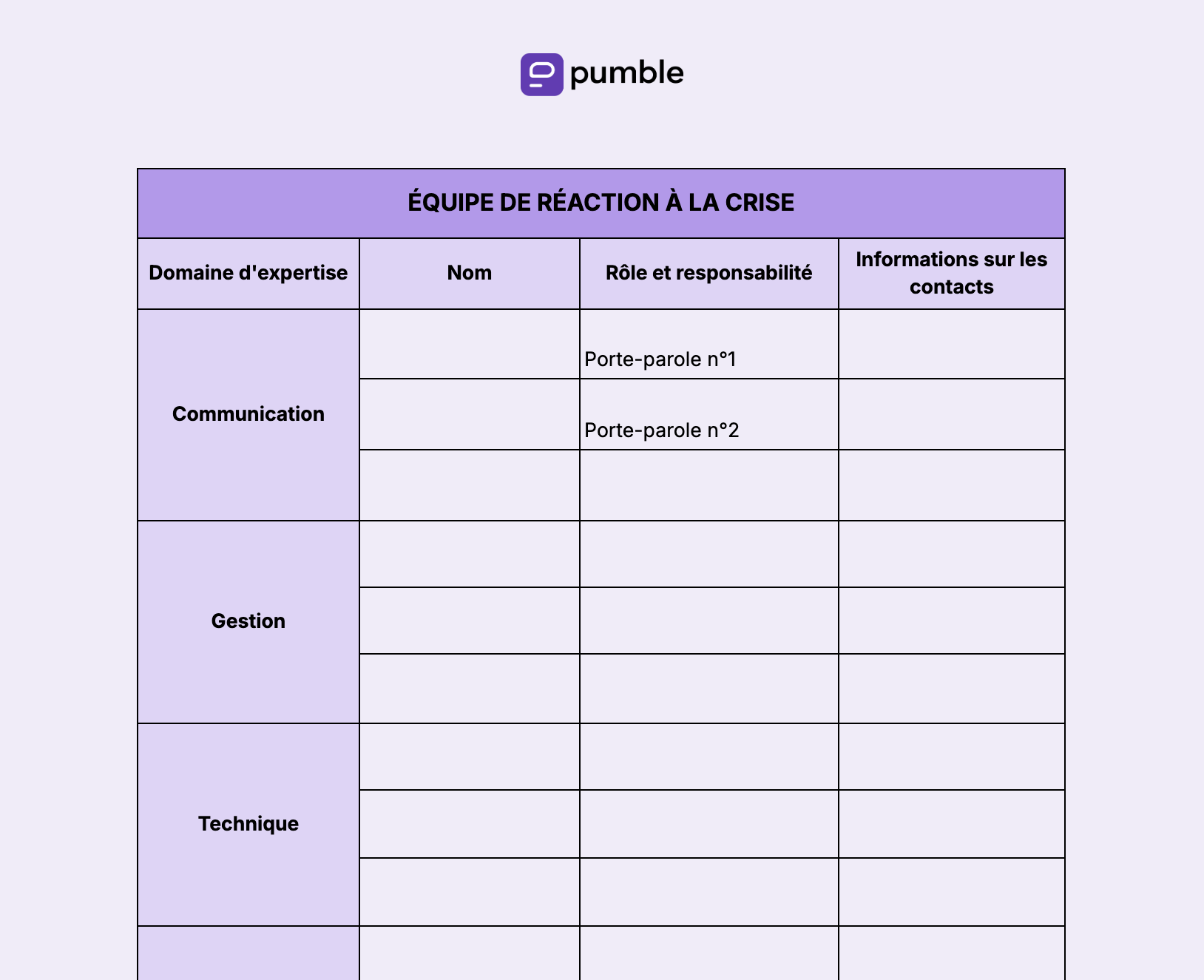
🔽 Modèle de plan général de communication de crise plan
Modèle de plan de communication de crise pour les écoles
Comprenez les risques potentiels du milieu scolaire et commencez à formuler votre réponse à l'aide d'un modèle de plan de communication de crise adapté à l'environnement éducatif.
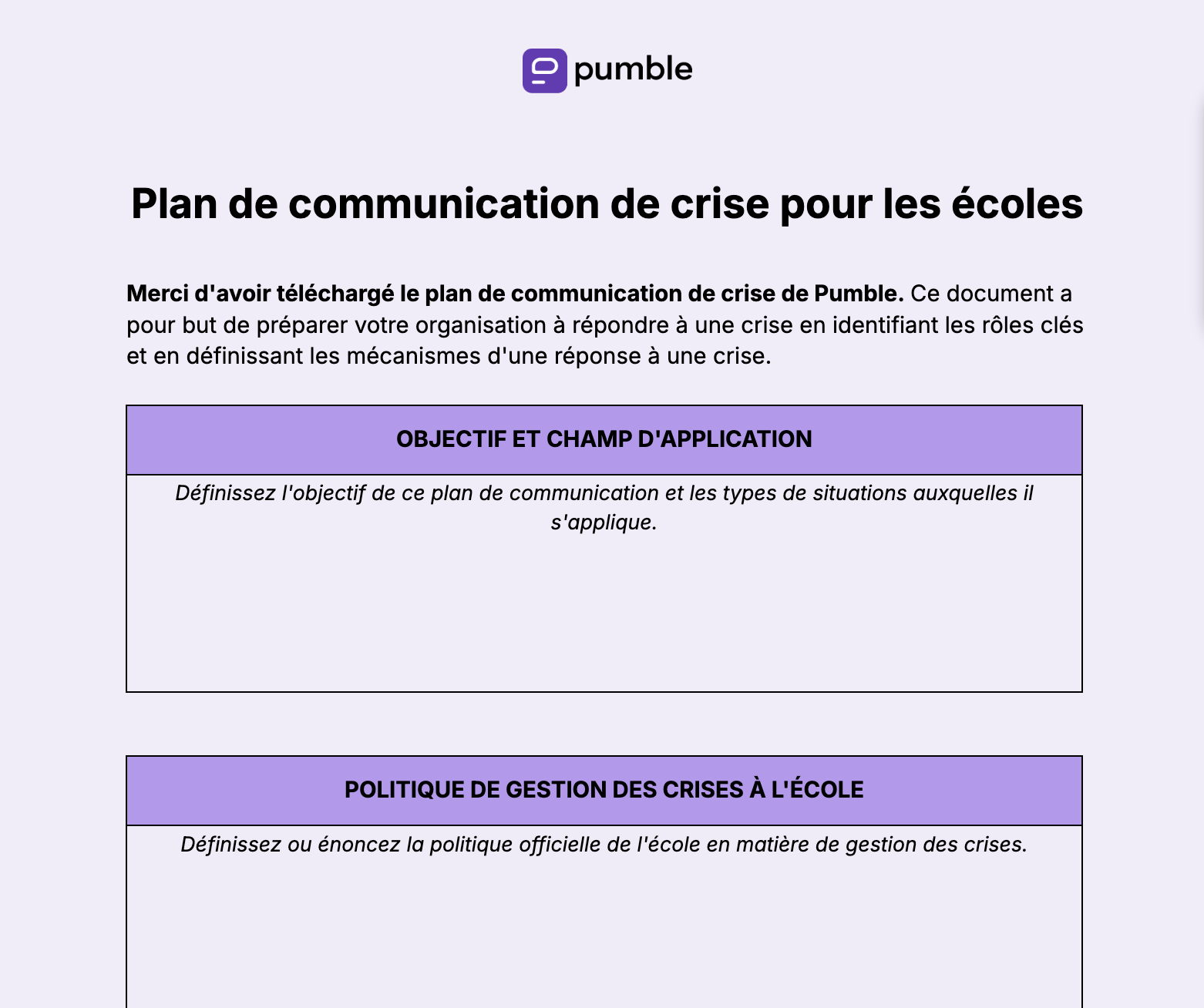
🔽 Modèle de plan de communication de crise pour les écoles
Modèle de plan de communication de crise pour les universités
Restez au courant de tous les scénarios de crise courants dans l'enseignement supérieur grâce à un modèle de plan de communication de crise axé sur l'université.
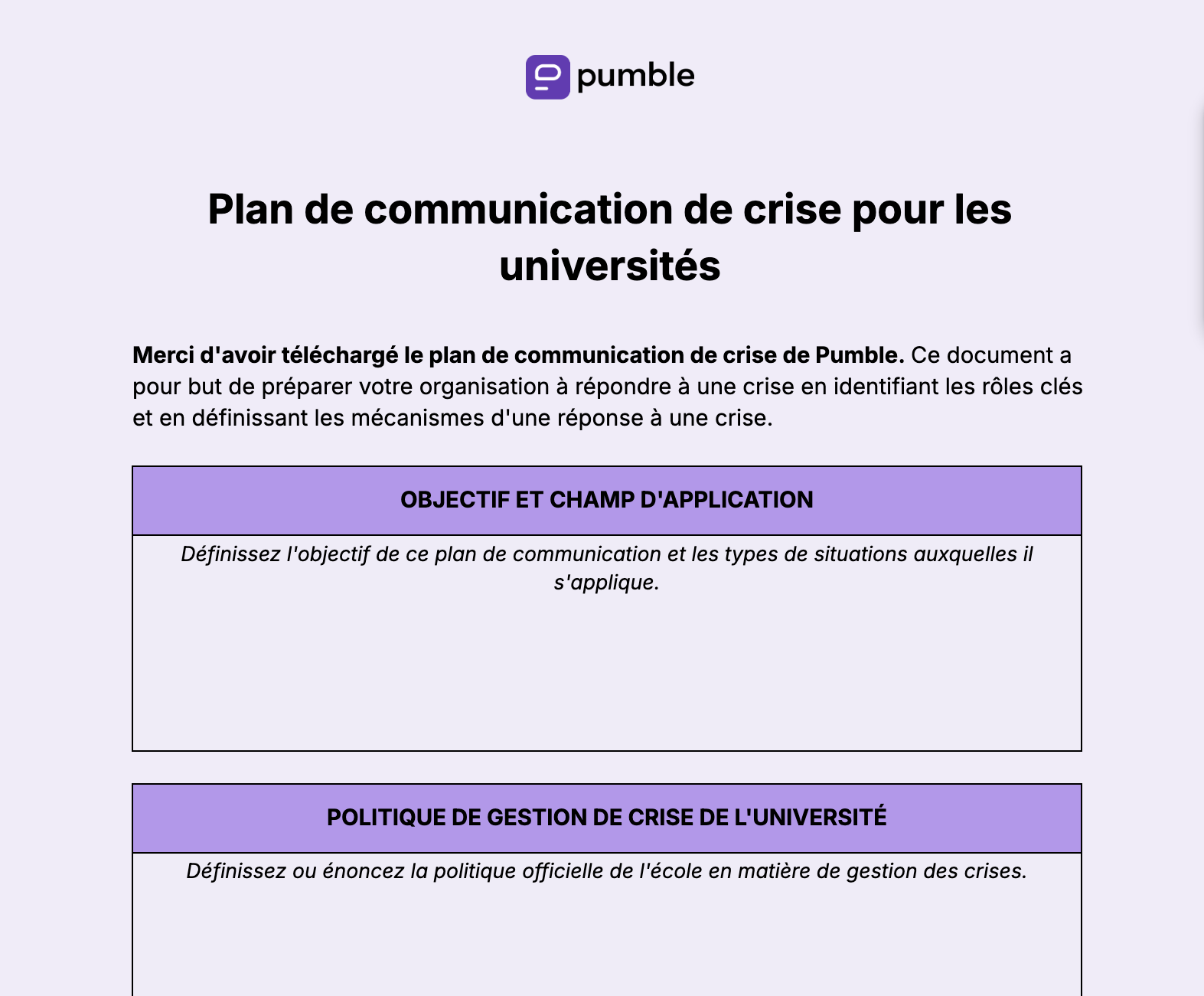
🔽 Télécharger le modèle de plan de communication de crise pour les universités
Modèle de plan de communication de crise pour les entreprises
Le monde volatile des affaires n'est jamais très loin de la prochaine crise. Préparez-vous à ce qui vous attend avec ce modèle spécialement conçu pour l'écosystème des entreprises.
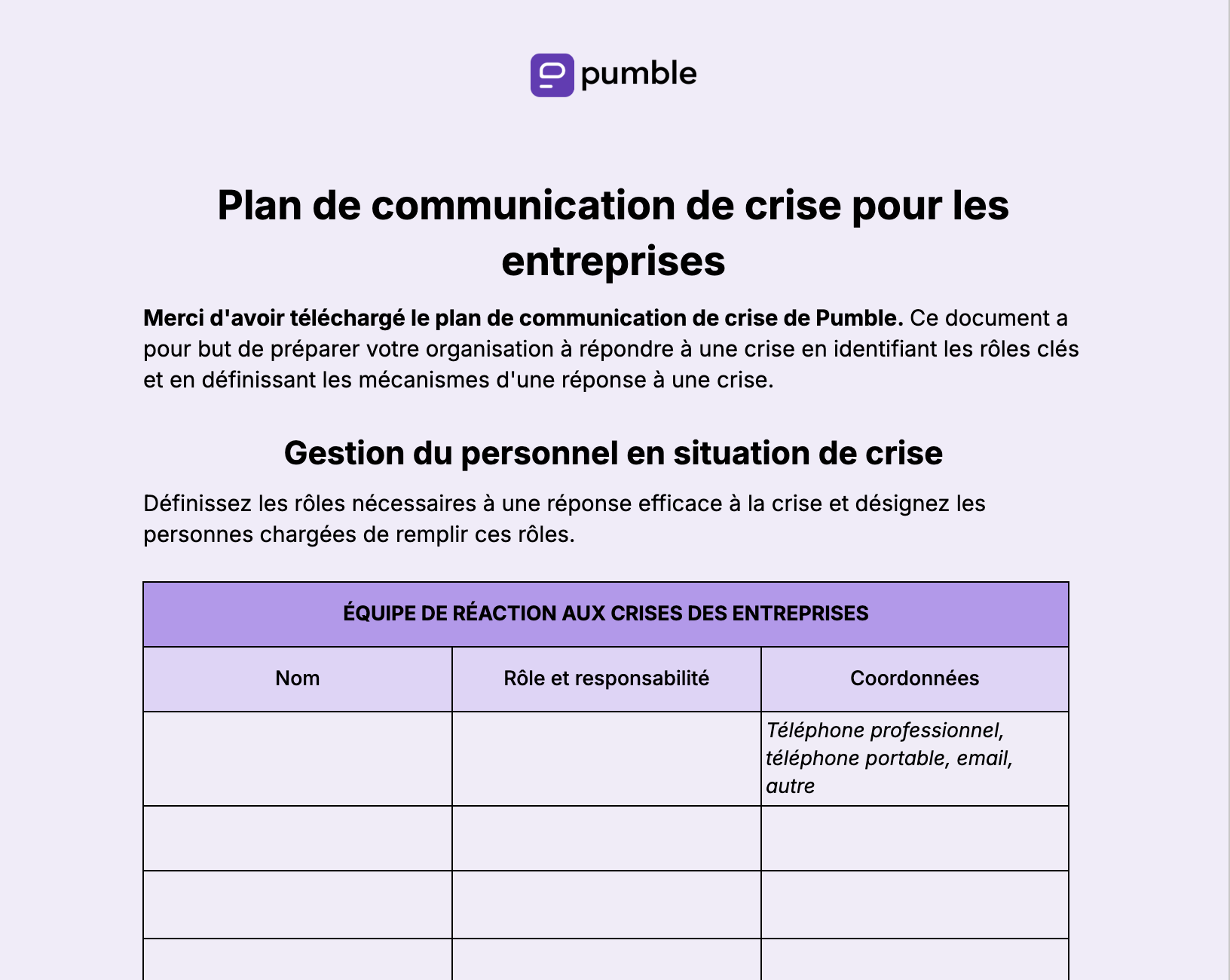
🔽 Télécharger le modèle de plan de communication de crise pour les entreprises
Modèle de plan de communication de crise technologique
Le monde de la technologie, de plus en plus complexe, est sujet à toutes sortes de perturbations. Gardez une longueur d'avance en planifiant et en vous préparant à la prochaine crise inévitable.
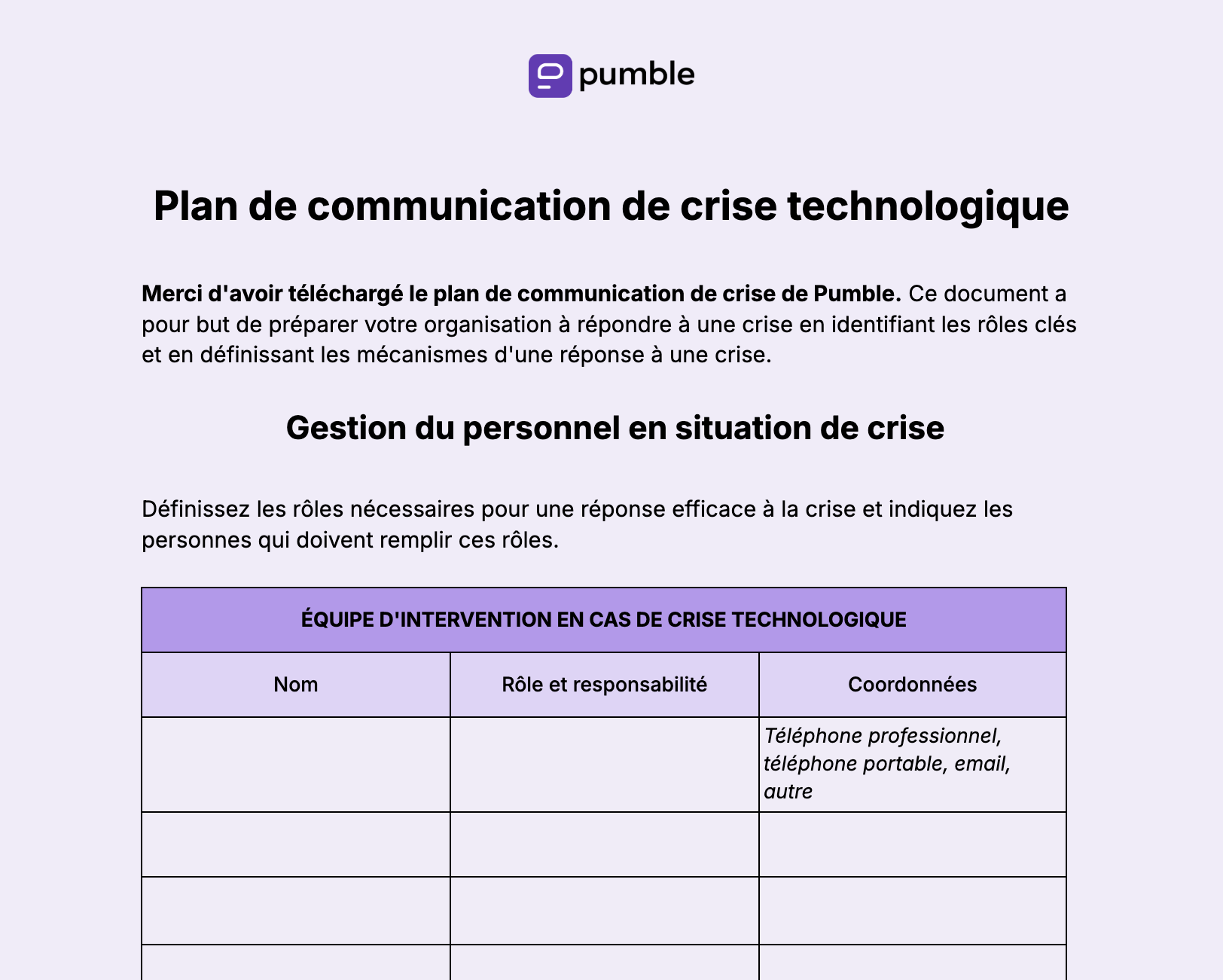
🔽 Télécharger le modèle de plan de communication de crise technologique
Modèle de plan de communication de crise pour le secteur de l'hôtellerie
Des clients mécontents aux épidémies, le secteur de l'hôtellerie et de la restauration a été un terrain fertile pour toute une série de crises. Mettez de l'ordre dans votre communication avant la prochaine.
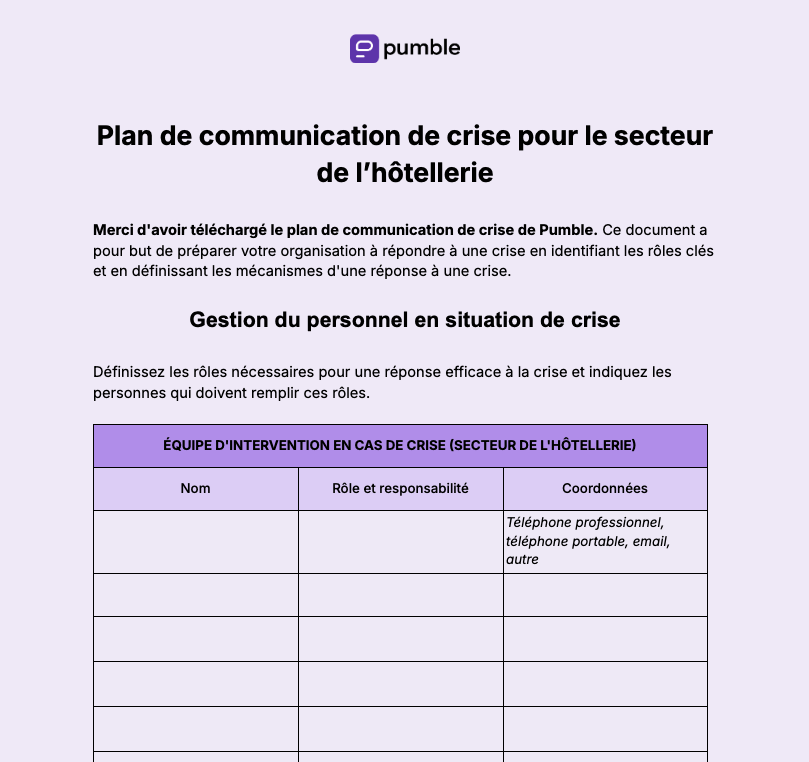
🔽 Télécharger le modèle de plan de communication de crise pour le secteur de l'hôtellerie
Modèle de plan de communication de crise pour les organisations à but non lucratif
Le secteur à but non lucratif a connu son lot de crises et de perturbations, ce qui oblige les organisations à se préparer aux turbulences à venir. Restez vigilants et préparés à toute éventualité.
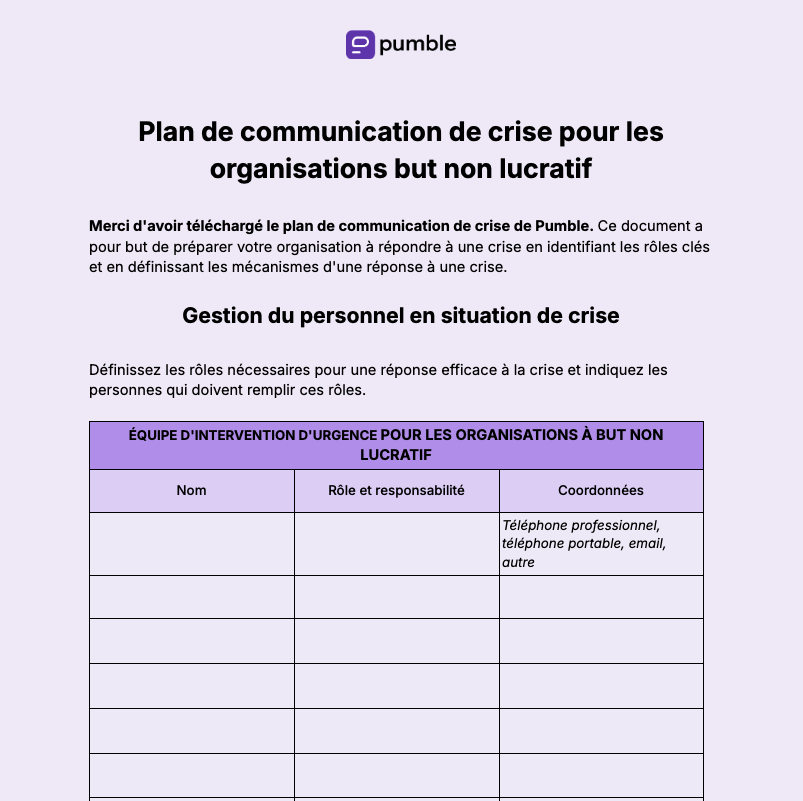
🔽 Télécharger le modèle de plan de communication de crise pour les organisations à but non lucratif
Modèle de plan de communication de crise pour les hôpitaux
Dans le secteur des soins de santé, les crises font partie du quotidien. Préparez-vous à conduire et à façonner la conversation pour naviguer sur les pentes glissantes de la communication de crise.
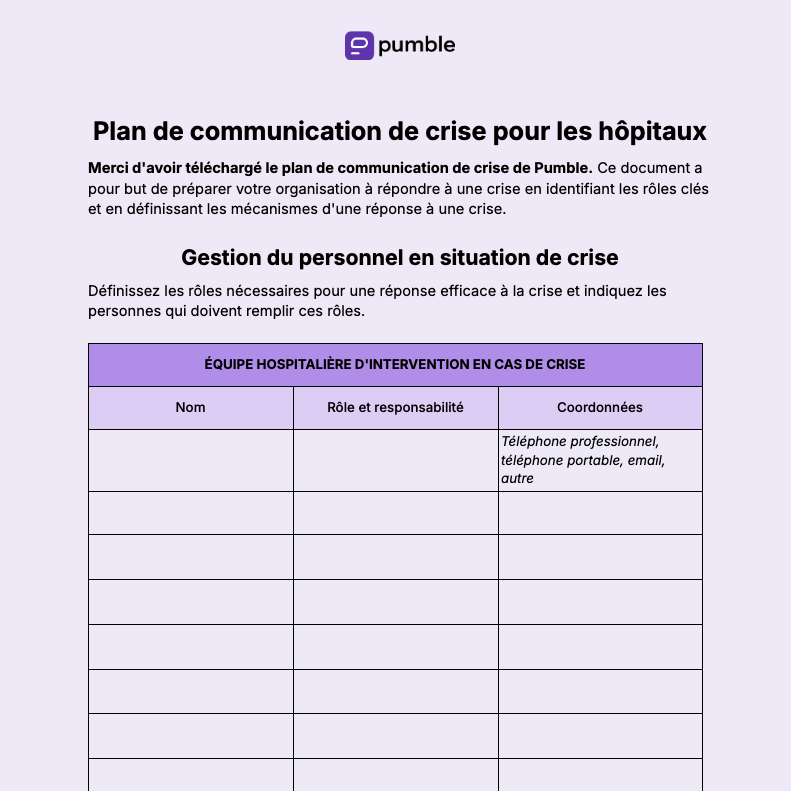
🔽 Télécharger le modèle de plan de communication de crise pour les hôpitaux
Modèle de plan de communication de crise le domaine du sport
Les egos, les droits acquis, les fans mécontents, et la « créativité » financière — le monde du sport est une crise permanente. Saisissez toute situation de crise en communiquant de manière proactive.
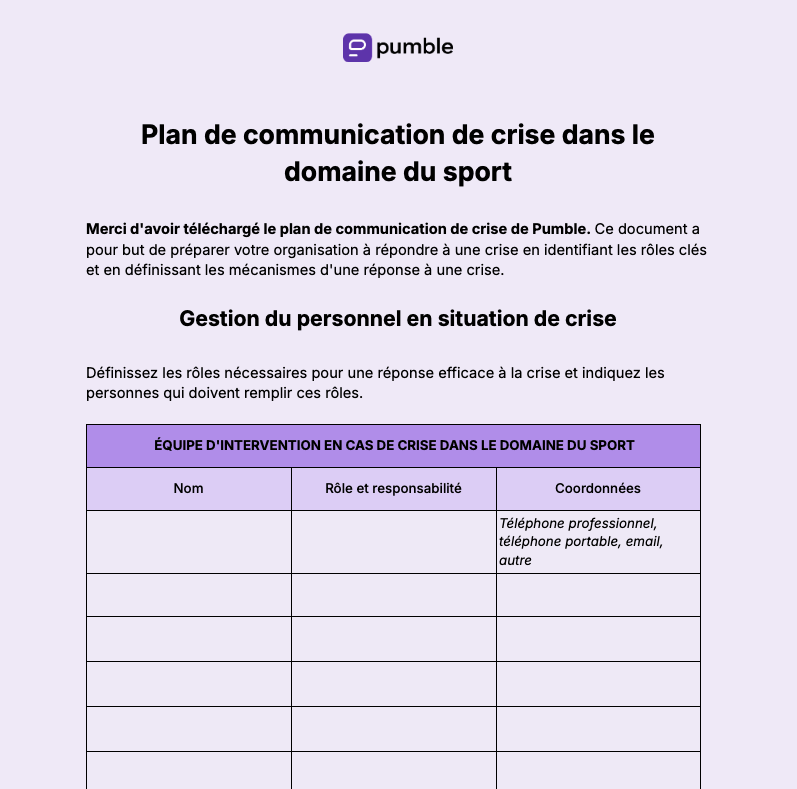
🔽 Télécharger le modèle de plan de communication de crise dans le domaine du sport
Modèle de plan de communication de crise pour le transport et la logistique
Le transport et la logistique sont un réseau complexe de pièces mobiles interconnectées. Faire dérailler une partie, c'est facilement faire dérailler l'ensemble. La prochaine crise est à nos portes — soyez prêts à y répondre !
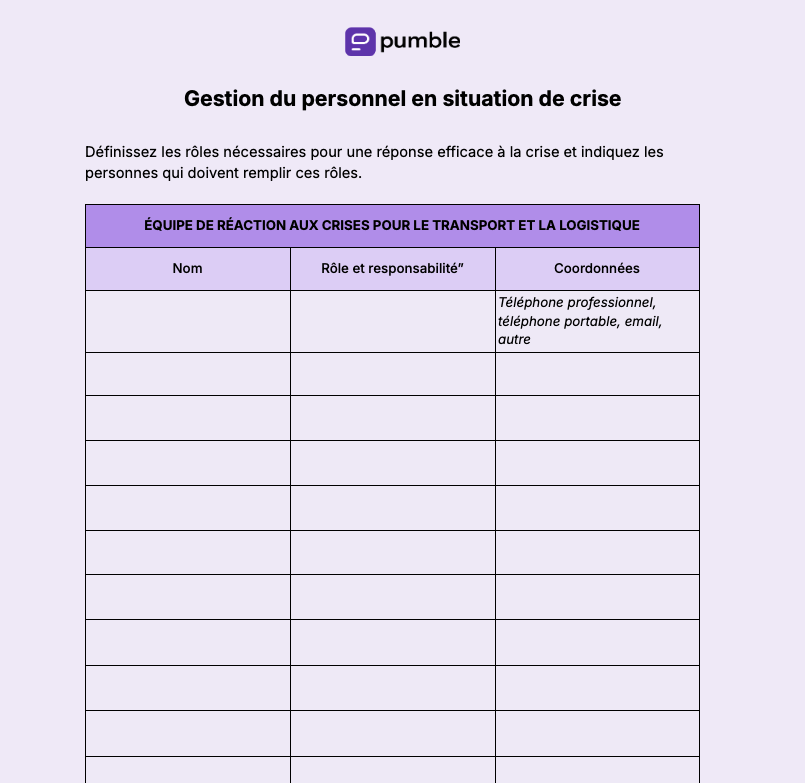
🔽 Télécharger le modèle de plan de communication de crise pour le transport et la logistique
Modèle de plan de communication de crise pour l'agriculture
La nourriture, l'air et l'eau sont les éléments constitutifs de la vie humaine. Chaque perturbation peut rapidement se transformer en une véritable crise. Permettez à votre organisation de gérer la conversation environnante à votre avantage.
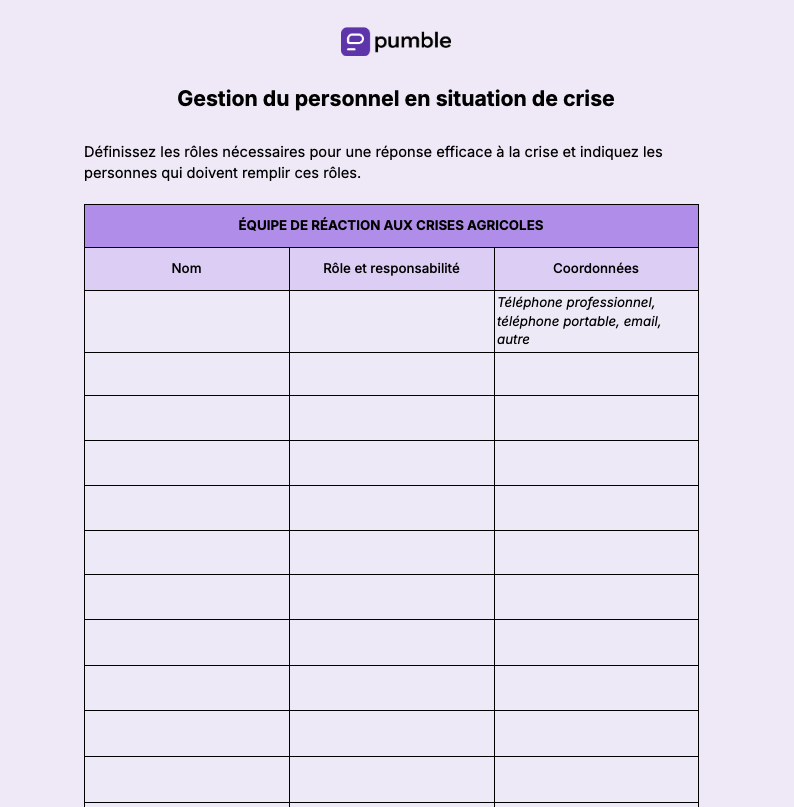
🔽 Télécharger le modèle de plan de communication de crise pour l'agriculture
Préparez-vous à un avenir inattendu avec Pumble
Comme nous l'avons mentionné ci-dessus, disposer de mécanismes d'alerte organisés pour les parties les plus importantes impliquées est le moyen le plus rapide de garder une longueur d'avance et d'agir rapidement dans les situations de communication de crise.
Le moyen le plus simple d'y parvenir est de préparer votre équipe — habituée à communiquer de manière organisée sur une plateforme de communication d'équipe telle que Pumble de CAKE.com.
Pumble est un QG numérique qui permet aux équipes de :
- Créer des canaux. Organisez vos conversations par thème, donnez accès aux personnes importantes ou à toute votre équipe, et informez rapidement les membres et sous-équipes concernés en cas de crise.
- Répondre dans des fils de discussion. Rationalisez les conversations grâce à des fils de discussion, facilitez et accélérez la navigation dans les messages.
- Inviter des invités. Intégrez des parties prenantes externes dans des canaux dédiés afin de les tenir informées ou d'obtenir leur avis en cas de crise.
- Personnaliser les notifications. Restez concentré sur les tâches les plus importantes dans les moments difficiles.
- Partager des fichiers et rechercher facilement. Naviguez efficacement parmi les informations, documents et données importants, avec un historique illimité des messages.
Réduisez les tensions, simplifiez vos efforts de réponse aux crises et restez efficace grâce à une plateforme de communication interne sécurisée et fiable.
Comment nous examinons cet article : Nos rédacteurs et éditeurs vérifient les articles et les mettent à jour lorsque de nouvelles informations sont disponibles, afin qu'ils soient toujours d'actualité.


